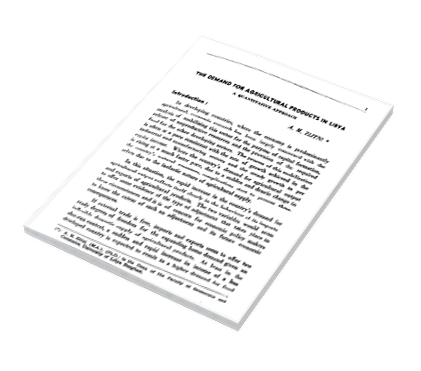THE DEMAND FOR AGRICULTURAL PRODUCTS IN LIBYA A QUANTITATIVE APPROACH
DOI:
https://doi.org/10.37376/deb.v5i2.3075Keywords:
THE DEMAND FOR AGRICULTURAL PRODUCTS IN LIBYA A QUANTITATIVE APPROACHAbstract
in developing countries, where the economy is predominantly agricultural, economic research has been largely concerned with the analysis of mobilizing this sector for the purpose of capital formation, release of unproductive resources and the provision of the required food for the other developing sectors. The process of this mobilization is often at a pace consistent with the rate of growth achieved in the industrial and manufacturing sectors and the steady growth in per capita income. Where the country's demand for agricultural output is rising at a much faster pace, due to a sudden and drastic change in the country's natural resources, complications start to present them selves due to the inelastic nature of agricultural supply.
In this situation, the rapid increase in the country's demand for agricultural output reflects itself clearly in the behaviour of its imports and exports of agricultural products. The two variables would seem to offer some evidence of the type of adjustment that takes place in these circumstances and it is of concern for economic policy makers to know the extent of such an adjustment and its future economic consequences.
If external trade is free, imports and exports seem to offer two ready degrees of freedom for the expanding home demand given an inflexible domestic supply of agricultural products. At least in the shot-run context, a sudden and rapid increase in income of a less developed country is expected to result in a higher demand for food
(*)
- A. M. Zlitni, (M.A.), (Ph.D.) is the Dean of the Faculty of Economics and Commerce, University of Libya Benghazi.
THE LIBYAN ECONOMIC AND BUSINESS REVIEW
and other agricultural material. Some of this increase in demand can be met by movements along the supply curve of the small commercial farm sector where supply may conceivably be thought of us responsive. But soon the increase in home demand is reflected in the country's external trade, with a tendency to increase imports and to contract exports. If this balancing process continues the country will rely heavily on imported food materials, the balance of payments problems present themselves and home producers will face heavy competition from efficient neighbour countries.
It can, therefore, be argued that some understanding of the export and import functions in a country typified by the above situation is important and can present some evidence of the likely demand for agricultural output which is in itself useful for policy measures that aim at a balanced growth within the various sectors of the economy.
The Libyan economy is a typical example of the above situation. It has until recently been a low income and predominantly agricultural economy. The share of the agricultural sector was estimated in 1958 to stand at 26% of gross domestic product at factor cost. And the total farm population, according to the 1960 Agricultural Census results, amounted to about 63% of the total population. About 43% of the total farm population are classified under tribal tenure, which indicates that a large proportion of the farming population lead a self subsistence life, together with a small commercial agricultural sector which provides for urban food requirements and export demand.
Since 1957, the country has started a new phase of economic change affected largely by the activities of oil exploration and the sudden flow of foreign capital which has increased rapidly through the ensuing months due to highly promising prospects of oil product ion. The amount of money spent locally by the oil companies rose from £L 4.3 millions during 1957 to £L 102.0 millions in 1964.
The injection effect of foreign capital, together with the rising oil
Downloads

Downloads
Published
How to Cite
Issue
Section
License
Copyright (c) 2022 Dirasat in Economics and Business

This work is licensed under a Creative Commons Attribution-NonCommercial-NoDerivatives 4.0 International License.







